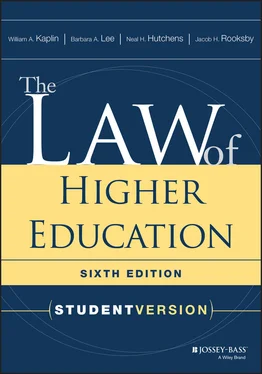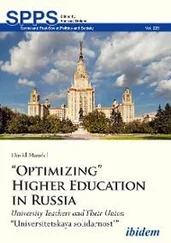Typically, when internal governance is the context, an institution's governing board or officers are pitted against one or more faculty members, staff members, or students; or members of these constituencies are pitted against one another. Chapters 3through 9of this book focus primarily on such issues. When external governance is the context, typically a legislature, a government agency or board, a private association or other private organization, or sometimes an affiliated entity or outside contractor is pitted against a higher educational institution (or system) or against officers, faculty members, or students of an institution. Chapters 10and 11of this book focus primarily on such issues.
The two categories of internal and external governance often overlap, especially in public institutions, and a problem in one category may often cross over to the other. An internal dispute about sexual harassment of a student by an employee, for instance, may be governed not only by the institution's internal policies on harassment but also by the external nondiscrimination requirements in Title IX of the Education Amendments of 1972 (see Section 8.5). Similarly, such a sexual harassment dispute may be heard and resolved not only through the institution's internal processes (such as a grievance mechanism) but also externally through the state or federal courts, the U.S. Department of Education, or a state civil rights agency. There are many examples of such crossovers throughout this book.
1.3.2 Internal governance.As a keystone of their internal governance systems, colleges and universities create “internal law” (see Section 1.4.3) that delineates the authority of the institution and delegates portions of it to various institutional officers, managers, and directors, to departmental and school faculties, to the student body, and sometimes to captive or affiliated organizations. Equally important, internal law establishes the rights and responsibilities of individual members of the campus community and the processes by which these rights and responsibilities are enforced. Circumscribing this internal law is the “external law” (see Section 1.4.2below) created by the federal government, state governments, and local governments through their own governance processes. Since the external law takes precedence over internal law when the two are in conflict, institutions' internal law must be framed against the backdrop of applicable external law.
Internal governance structures and processes may differ among institutions depending on their status as public, private secular, or private religious (as indicated in Section 1.3.1), and also depending on their size and the degree programs that they offer. The internal governance of a large research university, for instance, may differ from that of a small liberal arts college, which in turn may differ from that of a community college. Regardless of the type of institution, however, there is substantial commonality among the internal structures of U.S. institutions of higher education. In general, every institution has, at its head, a governing board that is usually called a board of trustees or (for some public institutions) a board of regents. Below this board is a chief executive officer, usually called the president or (for some public institutions) the chancellor. Below the president or chancellor are various other executive officers—for example, a chief business officer, a chief information officer, and a general counsel. In addition, there are typically numerous academic officers, chief of whom is a provost or vice president for academic affairs. Below the provost or vice president are the deans of the various schools, the department chairs, and the academic program directors (for instance, a director of distance learning, a director of internship programs, or a director of academic support programs). There are also managers and compliance officers, such as risk managers, facilities managers, affirmative action officers, and environmental or health and safety officers, and directors of particular functions, such as admissions, financial aid, and alumni affairs. These managers, officers, and directors may serve the entire institution or may serve only a particular school within the institution. In addition to these officers and administrators, there is usually a campus-wide organization that represents the interests of faculty members (such as a faculty senate) and a campus-wide organization that represents the interests of students (such as a student government association). Some institutions also maintain separate staff senates.
In addition to their involvement in a faculty senate or similar organization, faculty members are usually directly involved in the governance of individual departments and schools. Nationwide, faculty participation in governance has long been sufficiently established that internal governance is often referred to as “shared governance” or “shared institutional governance.” In recent times, as many institutions have been reconsidering their governance structures, usually under pressure to attain greater efficiency and cost-effectiveness, the concept and the actual operation of shared governance have become a subject of renewed attention. As institutions have increased their reliance on non-tenure-track faculty, an important issue related to shared governance involves the inclusion or exclusion of these faculty members from governance structures and bodies.
1.3.3 External governance.The states are generally considered to be the primary external “governors” of higher education, at least in terms of legal theory. State governments are governments of general powers that typically have express authority over education built into their state constitutions. They have plenary authority to create, organize, support, and dissolve public higher educational institutions (see Section 11.2.1); and they have general police powers under which they charter and license private higher educational institutions and recognize their authority to grant degrees (see Section 11.2.3). States also authorize out-of-state institutions to offer courses or degree programs online to residents in the state. The states also promulgate state administrative procedure acts, open meetings and open records laws, and ethics codes that guide the operations of most state institutions. In addition, states have fiscal powers (especially taxation powers) and police powers regarding health and safety (including the power to create and enforce criminal law) that they apply to private institutions and that substantially affect their operations. And more generally, state courts establish and enforce the common law of contracts and torts that forms the foundation of the legal relationships between institutions and their faculty members, students, administrators, and staffs. (See Section 1.4.2.4regarding common law and Section 1.4.4regarding the role of the courts.)
The federal government, in contrast to the state governments, is a government of limited powers, and its constitutional powers, as enumerated in the federal Constitution, do not include any express power over education. Through other express powers, however, such as its spending power (Section 11.3.1), and through its implied powers, the federal government exercises substantial governance authority over both public and private higher education. 3 Under its express powers to raise and spend money, for example, Congress provides various types of federal aid to most public and private institutions in the United States, and under its implied powers Congress establishes conditions on how institutions spend and account for these funds. Also under its implied powers, Congress provides for federal recognition of private accrediting agencies—among the primary external private “governors” of education—whose accreditation judgments federal agencies rely on in determining institutions' eligibility for federal funds (see Section 12.1.2). The federal government also uses its spending power in other ways that directly affect the governance processes of public and private higher educational institutions. Examples include the federally required processes for accommodating students with disabilities (see Section 8.4); for keeping student records (see Section 7.8.1); for achieving racial and ethnic diversity through admissions and financial aid programs (see Sections 7.2.5 and 7.3.4); and for preventing and remedying sex discrimination and sexual harassment (see, for example, Sections 8.5and 11.5.3).
Читать дальше












